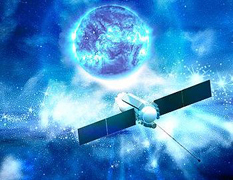CORONAS-PHOTON: TESIS Detected New Solar Mass Ejection. / June 17, 2009 /
 |
The greatest mass ejections on the Sun were registered this Sunday by TESIS telescopes installed on the CORONAS-PHOTON satellite. The source of the ejection is located on the back side of the Sun invisible from the Earth. About 103-106 mln t of ionized gas was ejected.
Last time, similar ejection occured in mid April. Two giant protuberances were emmitted, and at least one of them overrode solar gravity and escaped into outer space. The Sun sent its «hot hello» to Mercury and Mars which were on the way of the ionised flux.
It is hadr to predict solar flux trajectory, but this time its way will go far from the planets closest to our Earth. The Earth will also avoid solar impact. The protuberance will go in direction opposite to the direction to our planet, along the interplanetary magnetic lines.
Protuberances are very spectacular. For expmple, this time the telescope took the image of a giant arch in the solar crown more than 600 000km high (twice as long as the distance between the Earth and the Moon).
Interaction of the protuberances and the solar magnetic field is one of the most interesting issues in the solar physics. It is unknown, whether protuberacnes are caused by the processes in the magnetic field of the Sun (the field which `holds` plasma undergo reconstruction thus giving the way to protuberances), or it is a self-ejection effect when the substance goes up forcing it`s way through the magnetic structures, also tearing or straining these structures.
In two-three days this active area of the Sun which gave birth to one of the most extensive ejections this year will become visible from the Earth due to rotation of the Sun.
Print version
|




